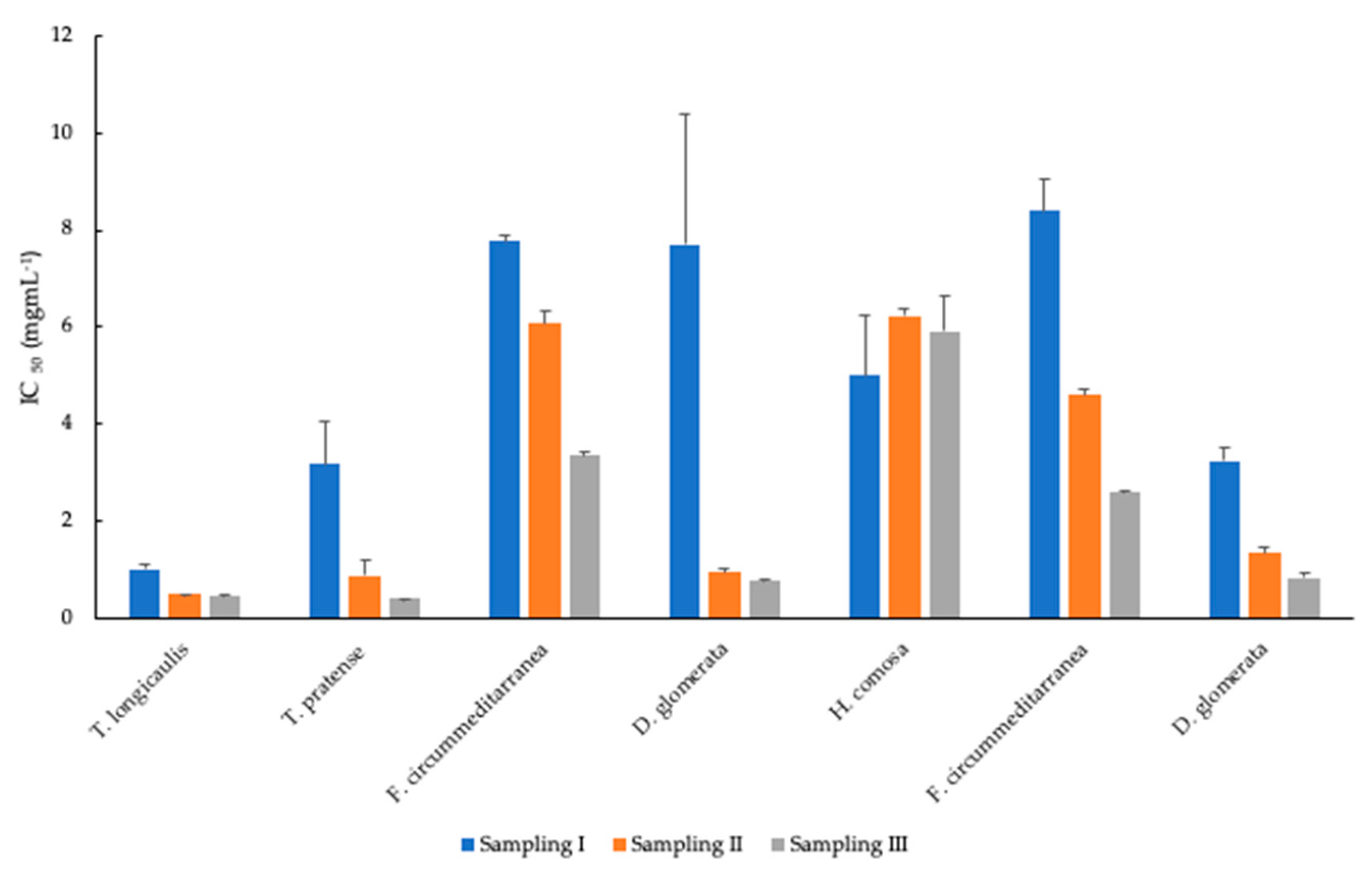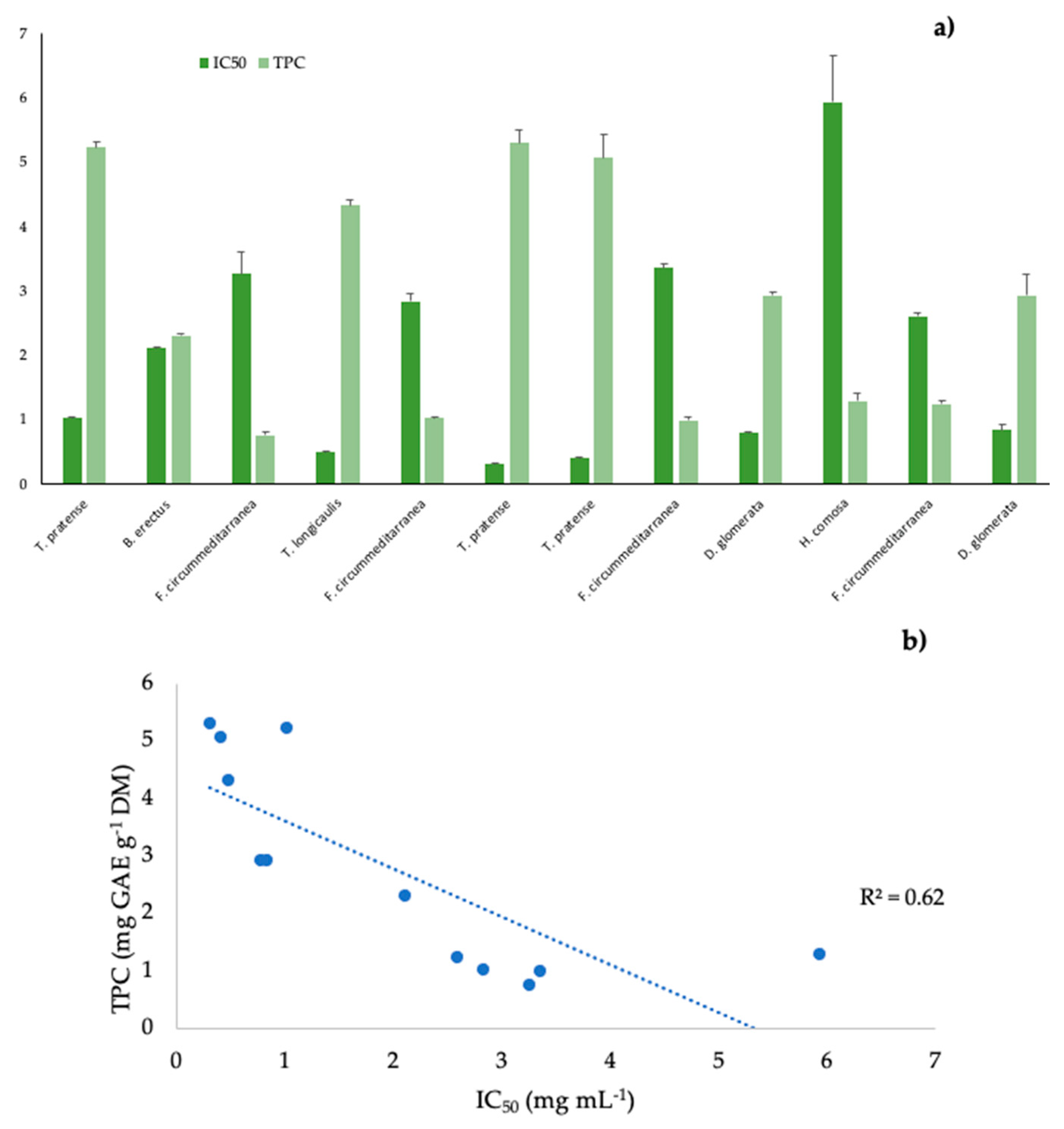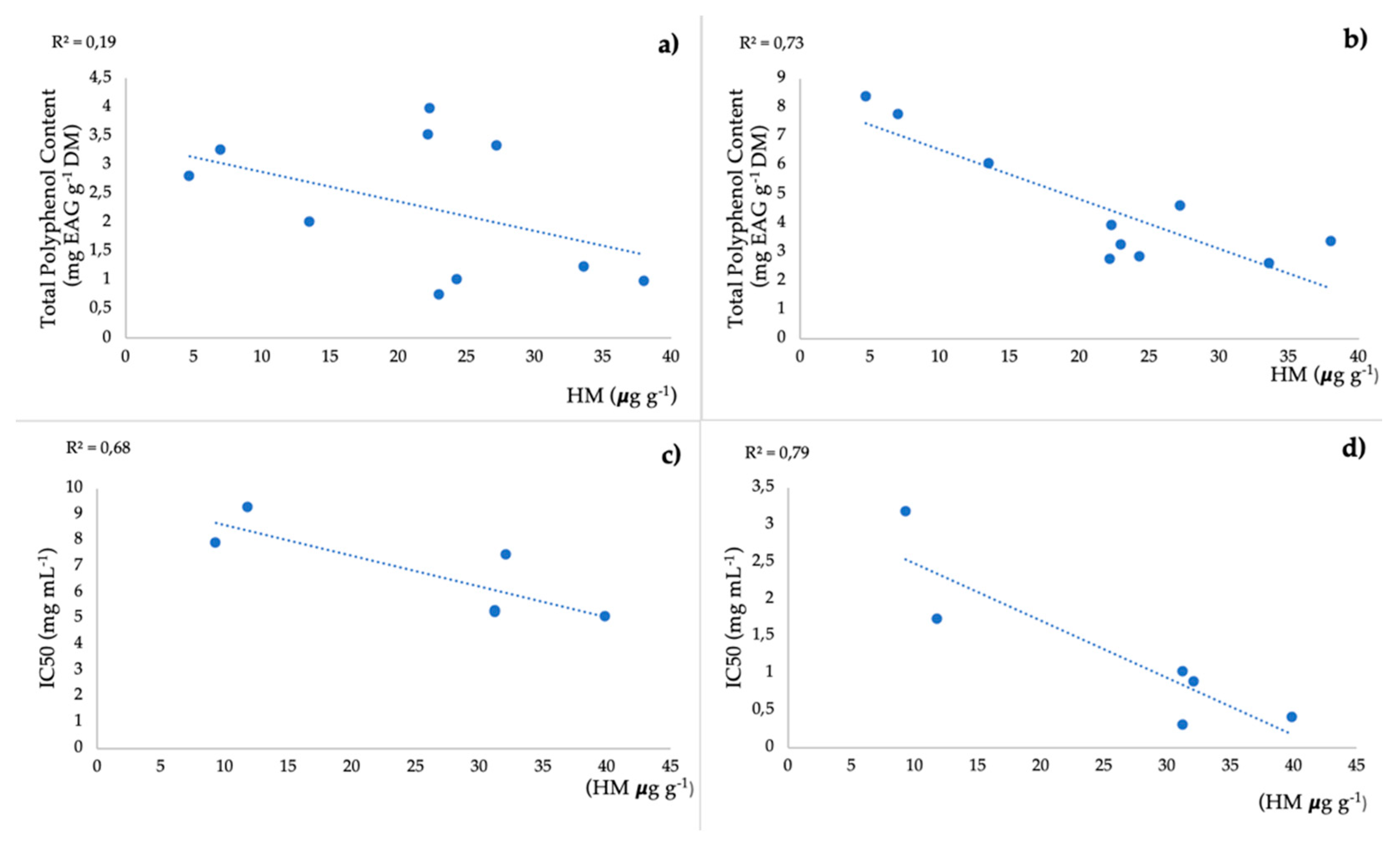Trend of Antioxidant Activity and Total Phenolic Content in Wild Edible Plants as Part of the Environmental Quality Assessment of Some Areas in the Central Italy
Abstract
1. Introduction
2. Materials and Methods
2.1. Study Sites
2.2. Pre-Treatment and Extraction
2.3. Determination of Total Polyphenol Content (TPC)
2.4. Determination of Total Tannin Content
2.5. Determination of Condensed Tannins (Proanthocyanidins)
2.6. Determination of Antioxidant Activity
2.7. Determination of Heavy Metals
3. Results
3.1. Total Polyphenol Content
3.2. Total Tannin Content
3.3. Condensed Tannins (Proanthocyanidins)
3.4. Antioxidant Activity
3.5. Heavy Metals
4. Discussion
5. Conclusions
Supplementary Materials
Author Contributions
Funding
Acknowledgments
Conflicts of Interest
References
- Silva, C.G.; Herdeiro, R.S.; Mathias, C.J.; Panek, A.D.; Silveira, C.S.; Rodrigues, V.P.; Renno, M.N.; Falca, D.Q.; Cerqueira, D.M.; Minto, A.B.M.; et al. Evaluation of antioxidant activity of Brazilian plants. Pharmacol. Res. Commun. 2005, 52, 229–233. [Google Scholar] [CrossRef] [PubMed]
- Lauridsen, C. From oxidative stress to inflammation: Redox balance and immune system. Poult. Sci. 2019, 98, 4240–4246. [Google Scholar] [CrossRef] [PubMed]
- Sharma, A.; Shahzad, B.; Rehman, A.; Bhardwaj, R.; Landi, M.; Zheng, B. Response of Phenylpropanoid Pathway and the Role of Polyphenols in Plants under Abiotic Stress. Molecules 2019, 24, 2452. [Google Scholar] [CrossRef] [PubMed]
- Masuda, T.; Yonemori, S.; Oyama, Y.; Takeda, Y.; Tanaka, T.; Andoh, T.; Shinohara, A.; Nakata, M. Evaluation of the Antioxidant Activity of Environmental Plants: Activity of the Leaf Extracts from Seashore Plants. J. Agric. Food Chem. 1999, 47, 1749–1754. [Google Scholar] [CrossRef] [PubMed]
- Elmastas, M.; Isildak, O.; Turkekul, I.; Temur, N. Determination of antioxidant activity and antioxidant compounds in wild edible mushrooms. J. Food Compos. Anal. 2007, 20, 337–345. [Google Scholar] [CrossRef]
- Asati, A.; Pichhode, M.; Nikhil, K. Effects of heavy metals on plants: An overview. Int. J. Appl. Innov. Eng. Manag. 2016, 5, 56–66. [Google Scholar]
- Michalak, A. Phenolic compounds and their antioxidant activity in plants growing under heavy metal stress. Pol. J. Environ. Stud. 2006, 15, 523–530. [Google Scholar]
- Waghorn, G.C.; McNabb, W.C. Consequences of plant phenolic compounds for productivity and health of ruminants. Proc. Nutr. Soc. 2003, 62, 383–392. [Google Scholar] [CrossRef]
- Kaurinovic, B.; Popovic, M.; Vlaisavljevic, S.; Schwartsova, H.; Vojinovic-Miloradov, M. Antioxidant profile of Trifolium pratense L. Molecules 2012, 17, 11156–11172. [Google Scholar] [CrossRef]
- Lendzion, K.; Gornowicz, A.; Bielawski, K.; Bielawska, A. Phytochemical composition and biological activities of Scorzanera species. Int. J. Mol. Sci. 2021, 22, 5128. [Google Scholar] [CrossRef]
- Galasso, S.; Pacifico, S.; Kretschmer, N.; Pan, S.; Marciano, S.; Piccolella, S.; Monaco, P.; Bauer, R. Influence of seasonal variation on Thymus longicaulis C. Presl chemical composition and its antioxidant and anti-inflammatory properties. Phytochem. Lett. 2014, 107, 80–90. [Google Scholar] [CrossRef] [PubMed]
- Khalighi-Sigaroodi, F.; Ahvazi, M.; Hadjiakhoondi, A.; Taghizadeh, M.; Yazdani, D.; Khalighi-Sigaroodi, S.; Bidel, S. Cytotoxicity and antioxidant activity of 23 plant species of Leguminosae family. Iran. J. Pharm. Res. IJPR 2012, 11, 295–302. [Google Scholar] [PubMed]
- Demir, S.; Ozer Yaman, S.; Ozlem Sener, S.; Ayazoglu Demir, E.; Aliyazicioglu, R.; Ozgen, U.; Mentese, A.; Deger, O.; Aliyazicioglu, K. Dorycnium pentaphyllum Extract Has Antiproliferative Effect on Human Cervix and Colon Cancer Cells. Nutr. Cancer 2019, 72, 504–512. [Google Scholar] [CrossRef]
- Hauck, B.; Gallagher, J.A.; Morris, S.M.; Leemans, D.; Winters, A.L. Soluble Phenolic Compounds in Fresh and Ensiled Orchard Grass (Dactylis glomerata L.), a Common Species in Permanent Pastures with Potential as a Biomass Feedstock. J. Agric. Food Chem. 2014, 62, 468–475. [Google Scholar] [CrossRef] [PubMed]
- Goufo, P.; Singh, R.K.; Cortez, I. A reference list of phenolic compounds (ingluding stilbenes) in Grapevine (Vitis vinifera L.) roots, woods, canes, stems and levaes. Antioxidants 2020, 9, 398. [Google Scholar] [CrossRef] [PubMed]
- Sami, F.J.; Soekamto, N.H.; Firdaus, L.J. Total phenolic, antioxidant activity and toxicity effect of Turbinaria decurrens extracts from South Sulawesi. J. Phys. Conf. Ser. 2019, 1341, 032008. [Google Scholar] [CrossRef]
- Nasseri, M.A.; Behravesh, S.; Allahresani, A.; Kazemnejadi, M. Phytochemical and antioxidant studies of Cleome heratensis (Capparaceae) plant extracts. Bioresour. Bioprocess. 2019, 6, 5. [Google Scholar] [CrossRef]
- Sultana, M.; Verma, P.K.; Raina, R. Quantitative analysis of total phenolic flavonoids and tannin contents in acetone and n-haxane extracts of Ageratum conyzoides. Int. J. ChemTech Res. 2012, 3, 996–999. [Google Scholar]
- Heil, M.; Baumann, B.; Andary, C.; Linsenmair, K.E.; McKey, D. Extraction and quantification of “condensed tannins” as a measure of plant anti-herbivore defence? Revisiting an old problem. Sci. Nat. 2002, 89, 519–524. [Google Scholar] [CrossRef]
- Molyneux, P. The use of the stable radical Diphenylpicrylhydrazyl (DPPH) for estimating antioxidant activity. Songklanakarin J. Sci. Technol. 2004, 26, 211–219. [Google Scholar]
- Reynaud, J.; Lussignol, M. The flavonoids of Lotus corniculatus. Lotus Newsl. 2005, 35, 78–82. [Google Scholar]
- Sastre, J.; Sahuquillo, M.; Vidal, M.; Rauret, G. Determination of Cd, Cu, Pb and Zn in environmental samples: Microwave-assisted total digestion versus auqa regia and nitric acid extraction. Anal. Chim. Acta 2002, 462, 69–72. [Google Scholar] [CrossRef]
- McCarthy, A.L.; O’Callaghan, Y.C.; Piggott, C.O.; FitzGerald, R.J.; O’Brien, N.M. Brewers’ spent grain; bioactivity of phenolic component, its role in animal nutrition and potential for incorporation in functional foods: A review. Proc. Nutr. Soc. 2013, 72, 117–125. [Google Scholar] [CrossRef] [PubMed]
- Starcević, K.; Krstulović, L.; Brozic, D.; Maurić, M.; Stojević, Z.; Mikulec, Ž.; Bajić, M.; Mašek, T. Production performance, meat composition and oxidative susceptibility in broiler chicken fed with different phenolic compounds. J. Sci. Food Agric. 2015, 95, 1172–1178. [Google Scholar] [CrossRef]
- Lattanzio, V. Phenolic compounds. In Natural Products; Ramawat, K.G., Merillon, J.M., Eds.; Springer: Berlin/Heidelberg, Germany, 2013. [Google Scholar]
- Pérez-López, U.; Sgherri, C.; Miranda-Apodaca, J.; Micaelli, F.; Lacuesta, M.; Mena-Petite, A.; Quartacci, M.F.; Muñoz-Rueda, A. Concentration of phenolic compounds is increased in lettuce grown under high light intensity and elevated CO2. Plant Physiol. Biochem. 2018, 123, 233–241. [Google Scholar] [CrossRef]
- Blancquaert, E.H.; Oberholster, A.; Ricardo-da-Silva, J.M.; Deloire, A.J. Effects of abiotic factors on phenolic compounds in the Grape Berry—A review. S. Afr. J. Enol. Vitic. 2019, 40, 1–14. [Google Scholar] [CrossRef]
- Julkunen-Tiitto, R.; Haggman, H.; Aphalo, P.J.; Lavola, A.; Tegelberg, R.; Veteli, T. Grow and defense in deciduous trees and shrubs under UV-B. Environ. Pollut. 2005, 137, 404–414. [Google Scholar] [CrossRef]
- Nenadis, N.; Llorens, L.; Koufogianni, A.; Diaz, L.; Font, J.; Gonzalez, J.A.; Verdaguer, D. Interactive effects of UV radiation and reduced precipitation on the seasonal leaf phenolic content/composition and the antioxidant activity of naturally growing Arbutus unedo plants. J. Photochem. Photobiol. B Biol. 2015, 153, 435–444. [Google Scholar] [CrossRef]
- Krol, A.; Amarowicz, R.; Weidner, S. The effects of cold stress on the phenolic compounds and antioxidant capacity of grapevine (Vitis vinifera L.) leaves. J. Plant Physiol. 2015, 189, 97–104. [Google Scholar] [CrossRef]
- Rezende, W.P.; Borges, L.L.; Santos, D.L.; Alves, N.M.; Paula, J.R. Effect of Environmental Factors on Phenolic Compounds in Leaves of Syzygium jambos (L.) Alston (Myrtaceae). Mod. Chem. Appl. 2015, 3, 157. [Google Scholar] [CrossRef]
- Hsu, C.Y. Antioxidant activity of extract from Polygonum aviculare L. Biol. Res. 2006, 39, 281–288. [Google Scholar] [CrossRef] [PubMed]
- Janda, T.; Szalai, G.; Rios-Gonzalez, K.; Veisz, O.; Paldi, E. Comparative study of frost tolerance and antioxidant activity in cereals. Plant Sci. 2003, 164, 301–306. [Google Scholar] [CrossRef]
- Hennenberg, K.J.; Bruelheide, H. Ecological investigations on the northern distribution range of Hippocrepis comosa L. in Germany. Plant Ecol. 2003, 166, 167–188. [Google Scholar] [CrossRef]
- Kucukboyaci, N.; Kadioglu, O.; Adiguzel, N.; Tamer, U.; Guvenc, A.; Bani, B. Determination of isoflavone content by HPLC-UV method and in vitro antioxidant activity of red clover (Trifolium pratense L.). Turk. J. Pharm. Sci. 2013, 10, 463–472. [Google Scholar]
- Nantitanon, W.; Yotsawimonwat, S.; Okonogi, S. Factors influencing antioxidant activities and total phenolic content of guava leaf extract. Food Sci. Technol. 2010, 43, 1095–1103. [Google Scholar] [CrossRef]
- Ozturk, N. Phenolic composition and antioxidant activity of the different extracts from Thymus longicaulis C Presl. Subsp. longicaulis var. longicaulis and T. longicaulis C. Presl. Subsp. longicaulis var. subisophyllus growing in Turkey. Pak. J. Pharm. Sci. 2015, 28, 465–472. [Google Scholar]
- Nordine, A.; Rivero-Perez, M.D.; Gonzalez-Sanjose, M.L.; El Meskaoui, A. Variation in Total polyphenols, Tannin and Catechin contents and Antioxidant activity among Moroccan thyme genotype. Arab. J. Med. Aromat. Plants 2022, 8, 99–116. [Google Scholar]
- Min, B.R.; Barry, T.N.; Attwood, G.T.; McNabb, W.C. The effect of condensed tannins on the nutrition and health of ruminants fed fresh temperate forages: A review. Anim. Feed Sci. 2003, 106, 3–19. [Google Scholar] [CrossRef]
- Maslennikov, P.V.; Chupakhina, G.N.; Skrypnik, L.N.; Feduraev, P.V.; Melnik, A.S. The contribution of polyphenols to plant resistance to Pb soil pollution. Int. J. Environ. Sci. 2018, 75, 719–731. [Google Scholar] [CrossRef]



| Site | Sampling I | Sampling II | Sampling III |
|---|---|---|---|
| Monteforte | n.a. | 0.67 ± 0.08 | 1.74 ± 0.32 |
| Verrino | n.a. | 0.63 ± 0.06 | 1.97 ± 0.43 |
| Guardata | 2.49 ± 0.42 | 0.77 ± 0.04 | 1.67 ± 0.56 |
| Guado Cannavina | 0.67 ± 0.08 | 1.23 ± 0.03 | 1.21 ± 0.65 |
Disclaimer/Publisher’s Note: The statements, opinions and data contained in all publications are solely those of the individual author(s) and contributor(s) and not of MDPI and/or the editor(s). MDPI and/or the editor(s) disclaim responsibility for any injury to people or property resulting from any ideas, methods, instructions or products referred to in the content. |
© 2023 by the authors. Licensee MDPI, Basel, Switzerland. This article is an open access article distributed under the terms and conditions of the Creative Commons Attribution (CC BY) license (https://creativecommons.org/licenses/by/4.0/).
Share and Cite
Notardonato, I.; Fantasma, F.; Monaco, P.; Di Fiore, C.; Saviano, G.; Giancola, C.; Avino, P.; De Felice, V. Trend of Antioxidant Activity and Total Phenolic Content in Wild Edible Plants as Part of the Environmental Quality Assessment of Some Areas in the Central Italy. Separations 2023, 10, 92. https://doi.org/10.3390/separations10020092
Notardonato I, Fantasma F, Monaco P, Di Fiore C, Saviano G, Giancola C, Avino P, De Felice V. Trend of Antioxidant Activity and Total Phenolic Content in Wild Edible Plants as Part of the Environmental Quality Assessment of Some Areas in the Central Italy. Separations. 2023; 10(2):92. https://doi.org/10.3390/separations10020092
Chicago/Turabian StyleNotardonato, Ivan, Francesca Fantasma, Pamela Monaco, Cristina Di Fiore, Gabriella Saviano, Carmen Giancola, Pasquale Avino, and Vincenzo De Felice. 2023. "Trend of Antioxidant Activity and Total Phenolic Content in Wild Edible Plants as Part of the Environmental Quality Assessment of Some Areas in the Central Italy" Separations 10, no. 2: 92. https://doi.org/10.3390/separations10020092
APA StyleNotardonato, I., Fantasma, F., Monaco, P., Di Fiore, C., Saviano, G., Giancola, C., Avino, P., & De Felice, V. (2023). Trend of Antioxidant Activity and Total Phenolic Content in Wild Edible Plants as Part of the Environmental Quality Assessment of Some Areas in the Central Italy. Separations, 10(2), 92. https://doi.org/10.3390/separations10020092









